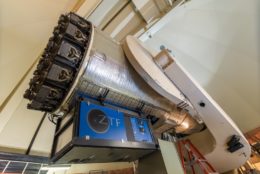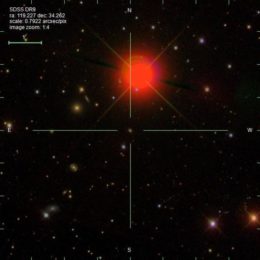What happens when a black hole makes a meal out of a passing star? So far, we’ve only detected a few dozen candidate tidal disruption events to help us answer this question — but now a new player is in the observing game.
Snacks for Black Holes
When a star passes within the tidal radius of a supermassive black hole, things don’t end well for the star. After the unfortunate object is torn apart by gravitational forces, some of the resulting debris accretes onto the black hole, causing a multi-wavelength flare.
To date, we’ve observed this flare emission from several dozen candidate tidal disruption events (TDEs), but many of them were only noticed significantly after the moment of disruption, when the flare emission is already ramping back down again. We also have only a handful of detections of TDEs across multiple wavelengths.

ZTF installed on the 1.2-meter Samuel Oschin Telescope at Palomar Observatory in California. [Caltech Optical Observatories]
A New Player
ZTF is a wide-field optical survey that hunts for transient objects in our night sky. ZTF images image the entire northern sky once every three nights, and the plane of the Milky Way twice a night. By scanning the same regions frequently, the survey can detect and monitor rapidly changing objects — like a suddenly rising tidal disruption flare.
ZTF began its first major public observing survey in mid-March 2018. In the weeks before that, ZTF was still in its commissioning phase, testing the camera and the alert pipeline. It was in this time that the survey detected its first tidal disruption event candidate, AT2018zr.

ZTF optical and Swift ultraviolet and optical light curves for AT2018zr. The data capture both the sudden rise and gradual decay of the flare. [van Velzen et al. 2019]
Early View of Destruction
The transient AT2018zr triggered a ZTF alert on 6 March 2018. In the weeks that followed, it was observed by additional telescopes across a number of wavelength bands. In a new publication led by Sjoert van Velzen (University of Maryland and New York University), team members detailed the ZTF and multi-wavelength follow-up observations of AT2018zr.
By reprocessing earlier ZTF image frames, van Veltzen and collaborators found that ZTF had actually captured this tidal disruption event starting in early February, 50 days before the peak of the flare light curve. These detailed optical observations, combined with the broadband follow-up, provide an unusually complete view of this flare.
Harbingers of Data to Come
With many more events like AT2018zr, we can hope to build a large sample of flares that will finally shed light on TDE processes. ZTF is conveniently poised to start producing those observations; estimates suggest that, now that ZTF is fully operational, it will produce ~30 TDE detections per year.What’s more, ZTF is providing researchers with a chance to test clever analysis techniques in advance of an even larger flood of data: the upcoming Large Synoptic Survey Telescope (LSST) is expected to detect ~1,000 TDEs per year! While only one event, AT2018zr is likely something more — the beginning of a new era for TDE observations.
Citation
“The First Tidal Disruption Flare in ZTF: From Photometric Selection to Multi-wavelength Characterization,” Sjoert van Velzen et al 2019 ApJ 872 198. doi:10.3847/1538-4357/aafe0c


2 Comments
Pingback: AAS Nova – New
Pingback: 1,000 AAS Nova Highlights and Five Years of Astronomy